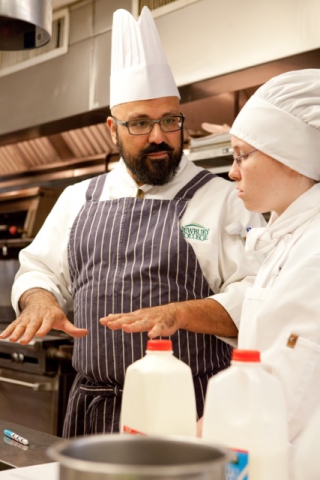
Handiwork by Working with Hands
04 September 2018Chefs and bakers alike learn to cook with all the body’s senses. But, is the sense of culinary touch being lost?
By Chef David Pazmiño of Newbury College
Food production in our technology-centric world separates us from our tactile relationship with ingredients. We are slowly losing our visceral relationship with food from the use of machines which increase production but limits our contact with food to sanitation guidelines that require gloved hands when touching food. Being a successful cook or baker requires using ALL of our senses.
One of France’s most famous bakers, Lionel Poilane, believed it was the act of the baker touching and making his or her bread that produced quality bread. A few years back, one of America’s famous bakers, Dorie Greenspan, filmed a CBS Sunday morning segment with Lionel making a French cookie called Punitions. Dorie describes the process as Lionel caresses the sugar and eggs before kneading in the butter and letting it slowly squeeze between his fingers. It was the experience of making the cookies just using his hands that allowed Lionel to accurately produce a delicate and airy cookie. Lionel believed that it was the tactile knowledge of the baker that produced a superior tasting and quality product.
When expanding the baking business, rather than mechanize the process Poilane’s daughter produced a factory embedded with individual “bakeries” controlled by one baker craftsman. In essence it was a factory of bakeries with each producing artisanal bread. For Poilane, she said, “Hands are more intelligent than a mixer.” In fact, hands as well as the lips contain some of the highest concentration of nerve endings in the human body. A successful cook, baker and chef needs the experience of producing food with their hands and not just with machines.
One of the first recipes I ever remember making was an oatmeal raisin cookie from a children’s cookbook calendar from Current Inc. I remember making that cookie by hand, kneading the butter and sugar between my fingers. The coarse and sandy texture of the sugar slowly breaking down the butter and the heat of my fingers softening the butter and creating a new mixture with the sugar. This was magic. This was alchemy. I made so many cookies that I set up a table in the lobby of my apartment building in New York City which had a daycare on the lower level. I would sell cookies to the parents as they picked up their children. Perhaps this is the root of my passion for baking, but it is this memory that had me thinking how to give my students a similar experience. Recipes, formulas, and techniques are great, but what is often missing in many of my students is that deep seated passion for cooking and for developing a craft with their hands.
Higher education puts much emphasis on expanding one’s knowledge by reading, thinking, engaging others in discussion, and writing critical papers. But the use of one’s hands is limited to flipping the page of a book, typing on a keyboard, or writing on a piece of paper. Why is it that we limit our knowledge gathering to our eyes, ears, and nose when our sense of touch informs us through direct experience? Starting from day one, I give my students two formulas, one of which is a straight dough with a relatively normal hydration rate of 62 percent. I throw in a small amount of bran along with a mini-side lecture about the composition of a wheat kernel. I have them roll up their sleeves and mix the dough by hand. I want them to experience the transformation of the flour from a powdery consistency to a strong and developed structure based on gluten.
I can tell them about gluten, I can show them the structure of gluten, but it isn’t until they feel it with their hands and the transformation of the dough that knowledge of what gluten is starts to sink in. I always take my demo dough and wash off all the starch until only the gluten is left. The other dough I give my students is an 80 percent hydrated dough. Being more slack, this needs time to develop the gluten. During bulk fermentation, I have the students fold the dough every 30 minutes. For both doughs, they are required to write down what they see, smell and taste. Yes, I have them taste a small part of the raw dough to get a sense of the flavors that are produced by the yeast. At the end of the day, the students leave having gained knowledge of bread production through ALL of their senses.
Making food by hand is not practical for most food establishments, but what it does is inform the student through the experiential process. Knowing by doing creates memories through our senses: the key is finding a way to engage them all.
